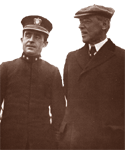 Memory of a distinguished American was honored in 1940 when the original Grayson Foundation was formed.
Admiral Cary Grayson had been best known as the personal physician to President Woodrow Wilson (right),
and at the time of his death, in 1938, he was chairman of the American Red Cross.
He was also a racing man, whose best horses included My Own, winner of the Saratoga Cup,
Saratoga Handicap, and Maryland Handicap.
Memory of a distinguished American was honored in 1940 when the original Grayson Foundation was formed.
Admiral Cary Grayson had been best known as the personal physician to President Woodrow Wilson (right),
and at the time of his death, in 1938, he was chairman of the American Red Cross.
He was also a racing man, whose best horses included My Own, winner of the Saratoga Cup,
Saratoga Handicap, and Maryland Handicap.
On occasion, Admiral Grayson was able to combine his medical profession with his other interests.
One such occasion was a spring day in 1919, when, upon Admiral Grayson’s suggestion, President and
Mrs. Wilson took a break from the Versailles Treaty negotiations and drove out to join Lord Derby for a
day at the races at Longchamp.
 Admiral Grayson (left) owned Blue Ridge Farm in Virginia, which is continued today by grandchildren.
After the death of Admiral Grayson, the $2,500 Grayson Stakes was inaugurated at Laurel. Matt Smart,
who had been training for Grayson at the time of his death, sent out the winner in Houghton P. Metcalf's
High Velocity. The 1 1/2-mile Grayson Stakes was run annually through 1949, and subsequent winners
included Heelfly, Pilaster, and Double Brandy.
Admiral Grayson (left) owned Blue Ridge Farm in Virginia, which is continued today by grandchildren.
After the death of Admiral Grayson, the $2,500 Grayson Stakes was inaugurated at Laurel. Matt Smart,
who had been training for Grayson at the time of his death, sent out the winner in Houghton P. Metcalf's
High Velocity. The 1 1/2-mile Grayson Stakes was run annually through 1949, and subsequent winners
included Heelfly, Pilaster, and Double Brandy.
Admiral Grayson was connected to some of the formulative stages which led eventually to the
establishment of the equine research foundation named for him. He was president of an organization
called the Gorgas Foundation, and he asked its director, Dr. Herbert Clark, to help advise the American
Thoroughbred Breeders Association (“ATBA”). The breeder’s organization in the late 1930s was
exploring various ways to address the promotion of research for horses.
 By 1939, a plan had been formulated whereby the ATBA would launch a campaign to raise $100,000 and,
once that amount had been pledged, the Grayson Foundation would become a reality. The Jockey Club,
under direction of its chairman, William Woodward Sr. (right), was among the initial respondents,
pledging 20 percent of the total.
By 1939, a plan had been formulated whereby the ATBA would launch a campaign to raise $100,000 and,
once that amount had been pledged, the Grayson Foundation would become a reality. The Jockey Club,
under direction of its chairman, William Woodward Sr. (right), was among the initial respondents,
pledging 20 percent of the total.
The Grayson Foundation became a reality in 1940, and its initial incorporators included Woodward,
while John Hay (Jock) Whitney was the Foundation’s initial president. The first grant was made
before the year was over, a $1,000 donation to the University of Pennsylvania Veterinary School
to continue its work on periodic ophthalmia. In 1940, the horse and mule were still deeply involved
in military defense, and the scope of the Foundation's efforts went far beyond the Thoroughbred,
to all breeds, although the impetus came from leaders in Thoroughbred racing.
From the beginning, the aim was to support research at existing institutions through funding
rather than carry out
the research itself. A statement by Woodward read in part that the formation
of the Foundation is "the result of the conviction of a large number of persons devoted to the raising
and breeding of horses that there is a positive need for further research in veterinary medicine and
in the breeding, raising, and handling of horses." Over nearly a half-century, the Grayson Foundation
operated as a separate entity, fulfilling the purposes of its founders despite constant limitations
on available funding.
For much of its history, the Foundation sought to disperse $100,000 annually in grants to specific
research projects. Its success in this goal resulted in support for a number of projects which
represented steps forward, among them being development of vaccines against Equine Viral Arteritis
and herpesvirus infections, determining causes of viral abortions leading to development of the most
effective vaccine yet developed, and influencing estrous cycles in mares to increase fertility.
The Jockey Club created a research foundation in 1984, and five years later this was merged with Grayson,
to be known since then as the Grayson-Jockey Club Research Foundation, Inc. (GJCRF,
the Foundation).
Grayson had a half-century background in research matters, and The Jockey Club had more wherewithal
financially, so in recent years the combined foundation has been able to disperse nearly $1 million
annually in grants.
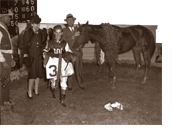 During the 1990s, three gifts of remarkable generosity were instrumental in enhancing the success of the
Foundation in fulfilling its mission. In 1991, the Robert J. Kleberg and Helen C. Kleberg Foundation donated
$2 million to Grayson-Jockey Club Research Foundation. Mr. Kleberg had studied genetics and as head of
King Ranch developed the Santa Gertrudis breed of cattle. He also was instrumental in development of the
American Quarter Horse, and the many excellent Thoroughbreds he bred included 1946 Triple Crown winner Assault, as pictured on the left with Mr. & Mrs. Kleberg.
During the 1990s, three gifts of remarkable generosity were instrumental in enhancing the success of the
Foundation in fulfilling its mission. In 1991, the Robert J. Kleberg and Helen C. Kleberg Foundation donated
$2 million to Grayson-Jockey Club Research Foundation. Mr. Kleberg had studied genetics and as head of
King Ranch developed the Santa Gertrudis breed of cattle. He also was instrumental in development of the
American Quarter Horse, and the many excellent Thoroughbreds he bred included 1946 Triple Crown winner Assault, as pictured on the left with Mr. & Mrs. Kleberg.
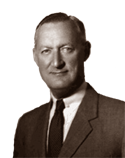 In 1993, the Foundation received another major gift when Paul Mellon (right) donated the $1 million bonus that
his Kentucky Derby winner Sea Hero won in the Chrysler Triple Crown Challenge. Mr. Mellon requested
that double that amount be raised in response, and this endowment drive was successfully concluded during
the 1995-96 fiscal year. The $1 million was double matched, as members of The Jockey Club and other
contributors donated a total of more than $2 million. Mr. Mellon passed away in 1999, leaving
$2.5 million to the Foundation's endowment. In 2000, the Foundation created the Rokeby Circle as the
designation of those who contribute $10,000 or more in a given year. Rokeby is the name of Mr. Mellon's
beloved Virginia estate, where he bred the champions Mill Reef, Arts and Letters, Fort Marcy, and Key to the Mint.
In 1993, the Foundation received another major gift when Paul Mellon (right) donated the $1 million bonus that
his Kentucky Derby winner Sea Hero won in the Chrysler Triple Crown Challenge. Mr. Mellon requested
that double that amount be raised in response, and this endowment drive was successfully concluded during
the 1995-96 fiscal year. The $1 million was double matched, as members of The Jockey Club and other
contributors donated a total of more than $2 million. Mr. Mellon passed away in 1999, leaving
$2.5 million to the Foundation's endowment. In 2000, the Foundation created the Rokeby Circle as the
designation of those who contribute $10,000 or more in a given year. Rokeby is the name of Mr. Mellon's
beloved Virginia estate, where he bred the champions Mill Reef, Arts and Letters, Fort Marcy, and Key to the Mint.
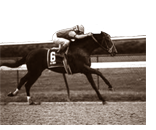 The Sea Hero (left) Triple Crown bonus, and resultant endowment drive, helped attain one of the other goals
set by previous chairman John Hettinger, i.e., raising the Foundation's net assets to the $10-million
level. Under the current chairman, Dell Hancock, growth continued; net assets stood at $18.1 million
at the conclusion of 2011.
The Sea Hero (left) Triple Crown bonus, and resultant endowment drive, helped attain one of the other goals
set by previous chairman John Hettinger, i.e., raising the Foundation's net assets to the $10-million
level. Under the current chairman, Dell Hancock, growth continued; net assets stood at $18.1 million
at the conclusion of 2011.
 One key stimulus was the Oxley Challenge, initiated in 2004. Under the direction of Foundation board
member John C. Oxley (right), his family’s Oxley Foundation pledged $1 million over four years contingent
on the Foundation raising a like amount in new income sources. The Foundation was successful in that match, and
so received $250,000 from the Oxley Foundation in each of four years.
One key stimulus was the Oxley Challenge, initiated in 2004. Under the direction of Foundation board
member John C. Oxley (right), his family’s Oxley Foundation pledged $1 million over four years contingent
on the Foundation raising a like amount in new income sources. The Foundation was successful in that match, and
so received $250,000 from the Oxley Foundation in each of four years.
In 1999, under direction of Drs. Gary Lavin (left, below) and Larry Bramlage, the Foundation’s process of
evaluating grants was reorganized. Instead of having separate committees of academicians and practicing
veterinarians, a single Research Advisory Committee (“RAC”) was created. The Committee includes 32 individuals
representing various research specialties and veterinary practices from across North America. Each year,
the committee is convened in January, having read all proposals submitted by the research community.
The RAC spends three days poring over the projects and rates them top to bottom, recommending the best
to the board of directors. The board then meets to determine how many projects can be funded in that year.
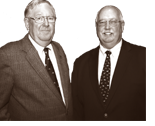 Dr. Bramlage was the original chairman of the RAC and remained in that post until he chose to step aside
in 2009. Our current chairman is Dr. Stephen Reed of Rood and Riddle Equine Hospital.
Dr. Bramlage was the original chairman of the RAC and remained in that post until he chose to step aside
in 2009. Our current chairman is Dr. Stephen Reed of Rood and Riddle Equine Hospital.
In 2006, in collaboration with The Jockey Club, the Foundation coordinated and underwrote the first
Welfare and Safety of the Racehorse Summit (“Summit”) hosted by Keeneland. That meeting, and a second
gathering of industry experts in 2008, generated a number of recommendations which the industry
has embraced to a large extent. The Jockey Club’s Thoroughbred Safety Committee endorsed recommendations
of the Summit, and the National Thoroughbred Racing Association’s race track accreditation program is based
in part on those recommendations. Also, the Summit helped organize the Equine Injury Database™ which is
designed to provide the industry much needed epidemiological analysis of trends, aimed at improving
injury rates nationally. Summits have been held in 2010, 2012, 2014, 2015, 2016 and 2018. The 2020 Summit was a series of webinars which are available on our website. The next summit is planned at Keeneland in June of 2022.
Since 1940, Grayson has provided more than $44.4 million to underwrite more than 450 projects at 48 universities in North America and overseas.
|



 Memory of a distinguished American was honored in 1940 when the original Grayson Foundation was formed.
Admiral Cary Grayson had been best known as the personal physician to President Woodrow Wilson (right),
and at the time of his death, in 1938, he was chairman of the American Red Cross.
He was also a racing man, whose best horses included My Own, winner of the Saratoga Cup,
Saratoga Handicap, and Maryland Handicap.
Memory of a distinguished American was honored in 1940 when the original Grayson Foundation was formed.
Admiral Cary Grayson had been best known as the personal physician to President Woodrow Wilson (right),
and at the time of his death, in 1938, he was chairman of the American Red Cross.
He was also a racing man, whose best horses included My Own, winner of the Saratoga Cup,
Saratoga Handicap, and Maryland Handicap.  Admiral Grayson (left) owned Blue Ridge Farm in Virginia, which is continued today by grandchildren.
After the death of Admiral Grayson, the $2,500 Grayson Stakes was inaugurated at Laurel. Matt Smart,
who had been training for Grayson at the time of his death, sent out the winner in Houghton P. Metcalf's
High Velocity. The 1 1/2-mile Grayson Stakes was run annually through 1949, and subsequent winners
included Heelfly, Pilaster, and Double Brandy.
Admiral Grayson (left) owned Blue Ridge Farm in Virginia, which is continued today by grandchildren.
After the death of Admiral Grayson, the $2,500 Grayson Stakes was inaugurated at Laurel. Matt Smart,
who had been training for Grayson at the time of his death, sent out the winner in Houghton P. Metcalf's
High Velocity. The 1 1/2-mile Grayson Stakes was run annually through 1949, and subsequent winners
included Heelfly, Pilaster, and Double Brandy.  By 1939, a plan had been formulated whereby the ATBA would launch a campaign to raise $100,000 and,
once that amount had been pledged, the Grayson Foundation would become a reality. The Jockey Club,
under direction of its chairman, William Woodward Sr. (right), was among the initial respondents,
pledging 20 percent of the total.
By 1939, a plan had been formulated whereby the ATBA would launch a campaign to raise $100,000 and,
once that amount had been pledged, the Grayson Foundation would become a reality. The Jockey Club,
under direction of its chairman, William Woodward Sr. (right), was among the initial respondents,
pledging 20 percent of the total.  During the 1990s, three gifts of remarkable generosity were instrumental in enhancing the success of the
Foundation in fulfilling its mission. In 1991, the Robert J. Kleberg and Helen C. Kleberg Foundation donated
$2 million to Grayson-Jockey Club Research Foundation. Mr. Kleberg had studied genetics and as head of
King Ranch developed the Santa Gertrudis breed of cattle. He also was instrumental in development of the
American Quarter Horse, and the many excellent Thoroughbreds he bred included 1946 Triple Crown winner Assault, as pictured on the left with Mr. & Mrs. Kleberg.
During the 1990s, three gifts of remarkable generosity were instrumental in enhancing the success of the
Foundation in fulfilling its mission. In 1991, the Robert J. Kleberg and Helen C. Kleberg Foundation donated
$2 million to Grayson-Jockey Club Research Foundation. Mr. Kleberg had studied genetics and as head of
King Ranch developed the Santa Gertrudis breed of cattle. He also was instrumental in development of the
American Quarter Horse, and the many excellent Thoroughbreds he bred included 1946 Triple Crown winner Assault, as pictured on the left with Mr. & Mrs. Kleberg. In 1993, the Foundation received another major gift when Paul Mellon (right) donated the $1 million bonus that
his Kentucky Derby winner Sea Hero won in the Chrysler Triple Crown Challenge. Mr. Mellon requested
that double that amount be raised in response, and this endowment drive was successfully concluded during
the 1995-96 fiscal year. The $1 million was double matched, as members of The Jockey Club and other
contributors donated a total of more than $2 million. Mr. Mellon passed away in 1999, leaving
$2.5 million to the Foundation's endowment. In 2000, the Foundation created the Rokeby Circle as the
designation of those who contribute $10,000 or more in a given year. Rokeby is the name of Mr. Mellon's
beloved Virginia estate, where he bred the champions Mill Reef, Arts and Letters, Fort Marcy, and Key to the Mint.
In 1993, the Foundation received another major gift when Paul Mellon (right) donated the $1 million bonus that
his Kentucky Derby winner Sea Hero won in the Chrysler Triple Crown Challenge. Mr. Mellon requested
that double that amount be raised in response, and this endowment drive was successfully concluded during
the 1995-96 fiscal year. The $1 million was double matched, as members of The Jockey Club and other
contributors donated a total of more than $2 million. Mr. Mellon passed away in 1999, leaving
$2.5 million to the Foundation's endowment. In 2000, the Foundation created the Rokeby Circle as the
designation of those who contribute $10,000 or more in a given year. Rokeby is the name of Mr. Mellon's
beloved Virginia estate, where he bred the champions Mill Reef, Arts and Letters, Fort Marcy, and Key to the Mint.  The Sea Hero (left) Triple Crown bonus, and resultant endowment drive, helped attain one of the other goals
set by previous chairman John Hettinger, i.e., raising the Foundation's net assets to the $10-million
level. Under the current chairman, Dell Hancock, growth continued; net assets stood at $18.1 million
at the conclusion of 2011.
The Sea Hero (left) Triple Crown bonus, and resultant endowment drive, helped attain one of the other goals
set by previous chairman John Hettinger, i.e., raising the Foundation's net assets to the $10-million
level. Under the current chairman, Dell Hancock, growth continued; net assets stood at $18.1 million
at the conclusion of 2011.  One key stimulus was the Oxley Challenge, initiated in 2004. Under the direction of Foundation board
member John C. Oxley (right), his family’s Oxley Foundation pledged $1 million over four years contingent
on the Foundation raising a like amount in new income sources. The Foundation was successful in that match, and
so received $250,000 from the Oxley Foundation in each of four years.
One key stimulus was the Oxley Challenge, initiated in 2004. Under the direction of Foundation board
member John C. Oxley (right), his family’s Oxley Foundation pledged $1 million over four years contingent
on the Foundation raising a like amount in new income sources. The Foundation was successful in that match, and
so received $250,000 from the Oxley Foundation in each of four years.  Dr. Bramlage was the original chairman of the RAC and remained in that post until he chose to step aside
in 2009. Our current chairman is Dr. Stephen Reed of Rood and Riddle Equine Hospital.
Dr. Bramlage was the original chairman of the RAC and remained in that post until he chose to step aside
in 2009. Our current chairman is Dr. Stephen Reed of Rood and Riddle Equine Hospital.